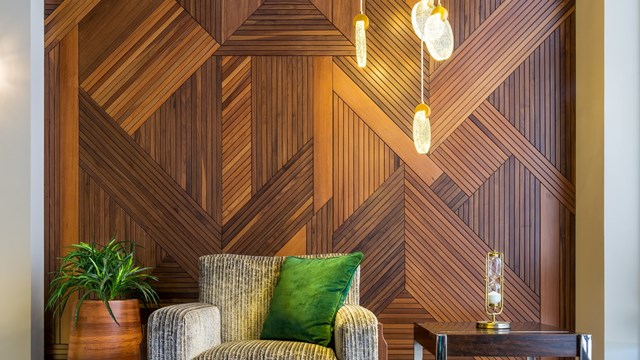
You only have one chance to make a first impression, and when it comes to co-op and condo buildings, your lobby is that first chance. The way a lobby is designed expresses what kind of building residents and visitors are walking into, both in style and in what kind of service residents can expect. "It sets the tone for the value of the building," says Marilyn Sygrove, owner of Sygrove Associates Design Group, Inc. "The lobby is the building's face. If a woman is going out to an evening function and you see her step out of the car and she has on a beautiful cloak and nice shoes and diamond earrings, that's the street. When she walks into the party and takes off her coat, that's the lobby. The lobby is the whole picture. It's the value, the dress, the smell of the perfume. The lobby is the whole romance of the building-you get a sense of what the apartments are like from the lobby."
Getting That Special Look
A lot of thought should go into how a lobby will look. Various factors-the developer, the residents, the neighborhood, the building-will influence what a lobby will become. Howard Zimmerman, of Manhattan-based Howard L. Zimmerman Architects, PC, says that in new construction, there is usually an interior firm that designs the lobby, hallways and other common areas. In the case of existing buildings that need a new or updated lobby, there are architectural firms that specialize in redesigning lobbies.
Lots of factors are taken into consideration before a lobby is designed and built. "In a new construction, [the lobby is discussed] at the beginning when they decide what market they're targeting," Zimmerman says. "In existing buildings, boards have a responsibility to maintain the building and fulfill the desires of their shareholders. And as people pay more and more money for their apartments, they're paying for the look of their building."
"The developer works with the marketing group when they put together the whole package, and the marketing people will identify a demographic," Sygrove says. "The age group, the structure of the families, what the residents spend their money on, what's important to them. From there, they will design," she says. "And a lot of it has to do with location. You're not going to get an upper East Side-type, stodgy formal building in an area with lots of lofts. It's driven somewhat by the neighborhood."
One architect with experience in lobby design points out that there are practical reasons for determining what a new building's lobby will look like early on.
"I find that people start thinking about it surprisingly early on in the process," says Robert Cane, PLLC. "First of all, it takes a long time to design a lobby and get consensus from the client and to get all the estimating done. With development projects, they want to purchase the lobby elements along with the large building elements. So that if they're buying $3 million worth of HVAC, they want to have a design for the lobby set so that they know what to buy and get the best prices."
Elegance in Lobby Design
According to Zimmerman, a high-end lobby being designed today is likely to feature traditional materials for a classic look. "Stone floors, wood walls, stone tops with classic sconces, nice lighting, a little material to soften it up," Zimmerman says in describing materials and features commonly used in lobbies. "We try to have new-looking lobbies that are modern but evoke more traditional times with warmer-looking materials." Jeff Sholeen, senior vice president of The Corcoran Group, describes the lobby of a certain building he knows that he says helps the building stand out.
"It has a library area, a meeting room, there's a billiards room off the lobby, there's a garden in back," he says. "Those type of things really make a difference."
Of course there's always something new and exciting in design, but a lobby that's too visually-striking may backfire. Going with a look that is too extreme may turn off some buyers and may appear dated more quickly than a more traditional look would.
"Some modern buildings may go with a radical design, but that can get dated," Zimmerman says. "There are looks that were popular in their day, but in hindsight they look like fads. I think most people want to stay away from something radical that could end up dated."
"People have to take a somewhat long-term view of what they're doing," agrees Crane. "Something might be very trendy and will look good for two or three or even five years, but then people might look at it and say, 'That looks very '80s.' Nothing will be completely timeless-and to some extent, any design will be the product of its time, but [going too far with a design] can be a pitfall."
A lobby should also fit the building and the neighborhood. Buyers who are interested in a prewar building have something in mind and most likely don't want something that's ultra-modern.
"There was a prewar building on the East Side where they did the lobby over in an avant-garde style with glass doors," Sholeen says. "It's beautifully done, but it's quite a shock to people who are interested in a prewar look. It's the same as when people renovate an apartment in a way that doesn't fit the location-that happens with lobbies."
Sholeen points out an example of a prewar building on Central Park West whose apartments always sold well. A lobby renovation in the 1980s didn't quite fit the building and had a negative impact on sales. When the lobby was redone in the '90s in a manner that kept the character of the building in mind, apartments started selling faster.
"It's hard to tell exact numbers, but I would say you can add 10 to 15 percent of the price of an apartment with the right lobby," Sholeen says. "It will also sell more quickly."
"It seems to me that there's a greater interest in contemporary architecture with modern materials-glass, stainless steel, simple woods," Cane says. "But if you're working with a prewar building, you have to respond to the context you're in. It's the rare prewar building that would look good with a very contemporary lobby." Zimmerman says the more classic style that is popular among buildings today is likely to remain in fashion longer than previous trends, such as the high-tech look of the 1970s. Zimmerman adds that as he works with clients, he will express an opinion if he thinks the board or design committee wants to do something that might be too much.
"You try to express your opinion and help guide them; I'll explain to them, 'This kind of radical design may look dated in five or 10 years,'" Zimmerman says. "And then you suggest a more traditional approach or less [drastic] one that still expresses the avant-garde look they want but on a more toned-down basis and let them decide."
Ultimately, of course, the decision is up to the developer or the building staff. "If they say, 'We want the most stylishly lobby possible,' I'll knock myself out for them," Zimmerman says. Sygrove says that many condo and co-op lobbies are becoming more like what you see in New York's better hotels.
"There's a very thin line now between a fine hotel concierge and a residential building-sometimes we can't tell the difference anymore," she says. "Everything from how the building staff is dressed, to very low-key entrances and exits to the desk looking like a hotel desk as opposed to a small doorman station."
Form vs. Function
Visitors are apt to judge a lobby based primarily on how it looks, but residents-and smart buyers-need not only something that's pleasing to the eye, but that also serves its purpose. Lobbies need to serve as an entrance with a security system, mailboxes and places to pick up packages. Zimmerman says that sometimes a great-looking design can conflict with a building's functionality.
"Often great architects, or not-so-great architects, go with a modern design, something that photographs well for a magazine but has no practicality," Zimmerman says. "There are a lot of great buildings by great architects that are world-renowned that people hate living in or working in because they're impractical. They look great in photos and win awards, but they're useless as far as the occupants go."
As time passes on, the lobby that did work some years back, may not work today.
"With time, what is designed today may not be as functional in 15 years as it is now," Sygrove says. "When luxury apartment buildings were first built, they had very limited package storage areas in the lobby; it wasn't something that needed to be addressed up front. Today, where in some buildings you only have one person on staff, everything has to be at that person's fingertips. And there weren't mail order and Internet purchases, so the whole structure of how people live changes over time."
"It's very important to get the planning right," seconds Cane. "The function of the lobby, you really have to start there. The doormen and concierge have to be visible, the mailroom has to be the right size." Cane says that package-storage areas are big now and mentions a lobby he designed about six years ago that had a very large package room at the time. Now just a few years later, the building is requesting a bigger room.
Time to Update
Lobbies need regular maintenance of course, but after 15 to 20 years, it may be time to update the area, though the change doesn't need to be drastic.
"You can update a lobby with a lighthanded refreshing," Zimmerman says. "Sometimes, the decision is made to rip it up and redo it, but normally if it was done right in the first place, it's timeless, and a major redesign isn't necessary. Wood paneling should just have to be refinished, stones only have to be re-polished, and maybe you'll have to update the lighting a little. You shouldn't have to redo a lobby every 10 years."
When a lobby loses its looks, the results can be bad for shareholders, especially when it comes to the value of apartments. Sygrove says that prospective buyers sometimes will walk out of a building if the lobby is shabby, ending potential sales before an apartment is even looked at.
But with prices being what they are, shareholders are likely to let management know if the lobby is becoming less appealing with time. Brokers also might share their opinions.
Brokers are constantly passing by, and so are occupants," Zimmerman says. "Eventually, they'll look at something and say, 'This lobby looks tired.' But when you're selling an apartment, the brokers will tell you, 'This is a beautiful lobby' or 'This needs a refresher.'"






Leave a Comment